INTRODUCTION
In poultry diets, dietary energy-contributing ingredients give a major part of production costs. Thus, the determination of the maximum energy level is important for reducing the overall feed cost per unit. It is known that dietary energy is one of the most contributing factors to the growth performance of poultry. Increasing dietary energy levels could improve the feed conversion rate by reducing feed intake [1–5]. However, up-to-date examination of the effect of energy levels on duck production has been rarely done. Furthermore, published data indicated the energy partitioning of ducks showed completely different patterns compared to the other poultry species (i.e., broiler chicken).
For example, Miclosamu [6] suggested that the dietary energy level from 2,750 kcal/kg to 3,050 kcal/kg exerts no significant changes on the growth performance of Muscovy duck. Similarly, recent research also indicates that dietary energy density continues to play an important role although the growth performance of modern broiler chickens is more responsive to amino acid densities [7]. In this regard, further research on the effect of dietary energy levels on ducks’ growth performance is imperative. Additionally, higher dietary energy composed to the standard level caused the deposition of excess abdominal fat or carcass fat in broilers [1,4,8], which could occur an economic loss for poultry producers. It has been determined that abdominal fat deposition resulting in adipogenesis in poultry could be affected by dietary factors such as carbohydrate, protein, and lipid sources [9]. This is of importance, especially with the fact that the White Pekin duck has higher fat levels than other avian species [10]. It is worthy to note that abdominal fat deposition could impact not only consumer choices but also the profitability of duck meat producers. This is because of health concerns the modern consumer has shown a preference for less fatty cut-up parts such as breasts (Pectoralis major).
There is an urgent need to generate up-to-date experimental data on modern duck genotypes because previous studies suggest that duck response to dietary energy [11,12], these experiments were conducted more than 40 years ago. To efficiently utilize the genetic potential of these poultry for specific production goals, it is necessary to determine the nutrient requirements of different poultry types [13]. A previous study evaluates the maximum crude protein levels in White Pekin ducks [14]. Thus, the objective of the current experiment was to investigate the effect of dietary energy levels on the growth performance and carcass traits and estimate the maximum dietary energy level of modern White Pekin ducks from hatch to 21 days.
MATERIALS AND METHODS
A total of 432 one-day-old male white Pekin ducklings with similar initial body weight were randomly allotted to 24 cages consisting of 6 treatments with 6 replicates. The dietary treatments consisted of a corn and soybean meal-based diet formulated with the nutrients to meet or exceed the National Research Council [15] specification for meat-type duck except for apparent metabolizable energy (AME) level which started from 2,700 kcal/kg to 3,200 kcal/kg with a 100 kcal/kg gap (Table 1). Diets were provided on an ad-libitum basis using a plastic feeder and the birds had free access to fresh clean drinking water via nipple drinkers throughout the experiment. Raised floor pens (120 × 180 cm2) were used to house the birds under the same environmental conditions. The temperature of the cages was maintained at 32 ± 2°C during week one post-hatch, and then it was gradually lowered leach 25 ± 2°C until the birds were 3 weeks old. Relative humidity was maintained at 70 ± 5% in the first week, 65 ± 5% in the second week, and 60 ± 5% thereafter. Furthermore, a continuous lighting regime of 25 lux was practiced during the experimental period.
Vitamin and mineral pre-mixture provided the following nutrients per kg of diet: vitamin A, 24,000 IU; vitamin D3, 6,000 IU; vitamin E, 30 IU; vitamin K, 4 mg; thiamine, 4 mg; riboflavin, 12 mg; pyridoxine, 4 mg; folacine, 2 mg; biotin, 0.03 mg; vitamin B8 0.06 mg; niacin, 90 mg; pantothenic acid, 30 mg; Fe, 80 mg (as FeSO4 ・H2O); Zn, 80 mg (as ZnSO4 ・ H2O); Mn, 80 mg (as MnSO4 ・H2O); Co, 0.5 mg (as CoSO4 ・H2O); Cu, 10 mg (as CuSO4 ・ H2O); Se, 0.2 mg (as Na2SeO3); I, 0.9 mg (as Ca [IO3] ・2H2O).
Body weights (BW) and feed intakes were measured on day 1, 7, 14, 21. Using the BW and feed intake data, average daily gain (ADG), average daily feed intake (ADFI), and feed conversion ratio (FCR) were calculated. Moreover, the daily mortality of birds in each replicate was recorded when the death occurred.
A duck was randomly selected from each pen (six ducks per treatment) on day 21. The individual live body weight of the selected bird was measured and euthanized with cervical dislocation [14]. The carcass was skinned and eviscerated to measure empty body weight. Breast meat, leg meat (with thigh), and abdominal fat were collected to estimate the effects of dietary energy levels on meat (leg and breast muscle) and abdominal fat accumulation.
Data were analyzed using the one-way ANOVA technique, a completely randomized design by using the SPSS software package (Version 24, IBM SPSS 2012, Chicago, IL, USA). The pen was used as the experimental unit for all growth performance measurements. Selected individual birds were used as the experimental unit for the carcass measurement. Mean differences were considered significant at p < 0.05. Tukey’s multiple comparison test was used to determine the significant differences between experimental groups when the mean shows a significant difference. Nutritional response models were analyzed with a broken-line model and quadratic model conducted to estimate the maximum dietary energy level [16].
RESULTS
All birds remained healthy and performed well; Sudden Death Syndrome (SDS), death from stress, and disease were not noticed.
The data for the growth performance of ducklings fed different dietary AME levels are presented in Table 2. Ducklings fed a 3,200 kcal/kg AME level diet indicate the highest BW. In addition, ducklings fed an AME range of 3,100 kcal/kg to 2,800 kcal/kg, showed medium BW. Whereas ducks fed a 2,700 kcal/kg AME level diet exhibited the lowest (p < 0.05) BW on day 21. A similar trend was noted for the ADG over the entire experimental period. Similarly, ducks fed higher dietary AME levels than 2,900 kcal/kg displayed lower FCR (p < 0.05) on average during the whole experimental period. Following those results, ducks fed more than 3,200 kcal/kg dietary AME level diet exhibited the highest BW and ADG, and the lowest FCR (p < 0.05).
Carcass quality is presented in Table 3. Ducks fed a higher AME level diet had higher (p < 0.05) abdominal fat content and leg meat portion. However, no difference (p > 0.05) in breast meat portion
Figs. 1 to 6 show linear and quadratic plateau analysis to estimate the maximum requirement level of dietary AME. Fig. 1 shows the linear plateau day 21 BW level to be at 3,000.00 kcal/kg and the quadratic plateau requirement was determined at 3,100.00 kcal/kg. Fig. 2 shows the requirement of ADG from day 14 to 21. The linear plateau level was at 3,053.45 kcal/kg and the quadratic plateau requirement was estimated at 3,115.92 kcal/kg. Fig. 3 shows the requirement of ADG from day 1 to 21, the linear plateau requirement level was at 3,167.04 kcal/kg and the quadratic plateau requirement was estimated to be 3,299.00 kcal/kg. Fig. 4 displays the requirement of ADFI from day 14 to 21 and the linear plateau requirement level was at 3,000.00 kcal/kg whereas the quadratic plateau requirement was at 3,306.26 kcal/kg. Fig. 5 exhibits the FCR requirement from day 1 to 7 and the linear plateau level shows 3,173.03 kcal/kg and the quadratic plateau estimate is at 3,154.17 kcal/kg. Fig. 6 shows the requirement of FCR from day 1 to 21 and the linear plateau level is shown at 3,173.00 kcal/kg while the quadratic plateau requirement was gauged at 3,104.14 kcal/kg.
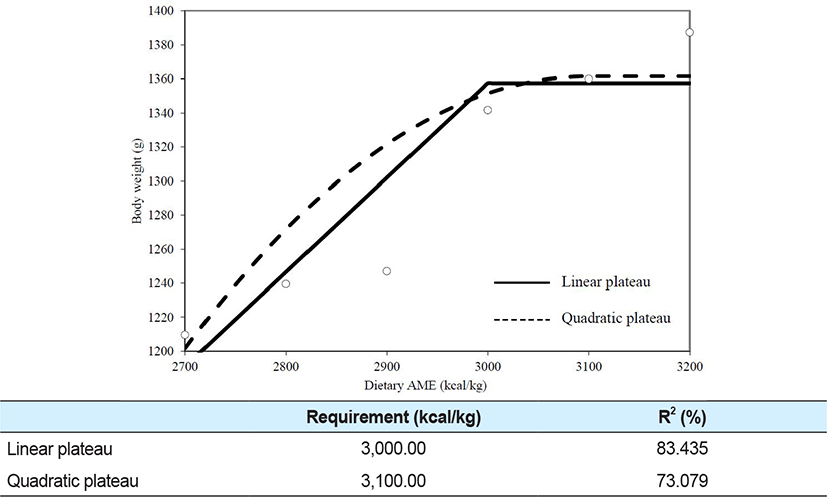
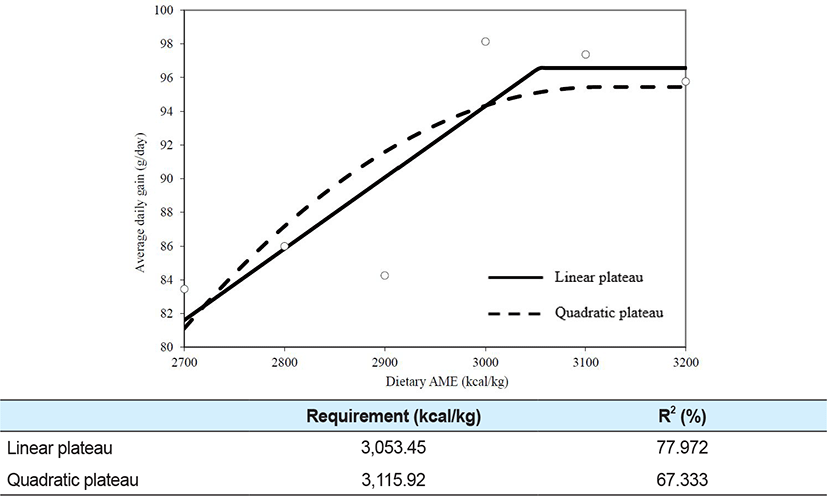
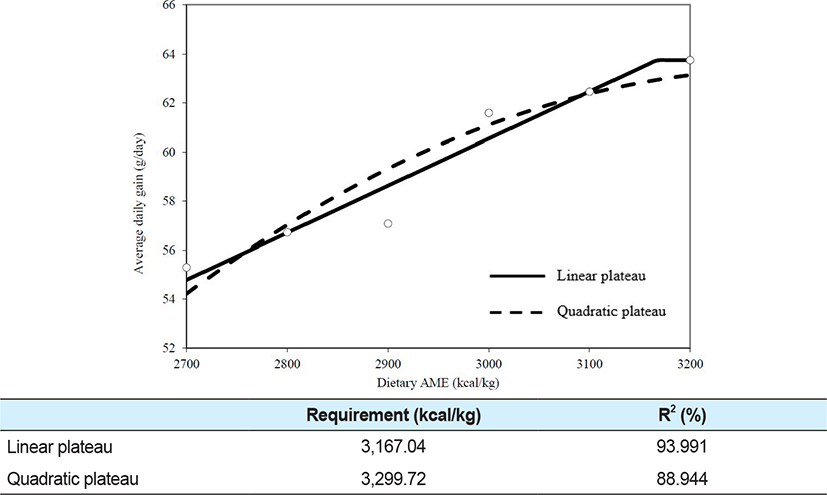
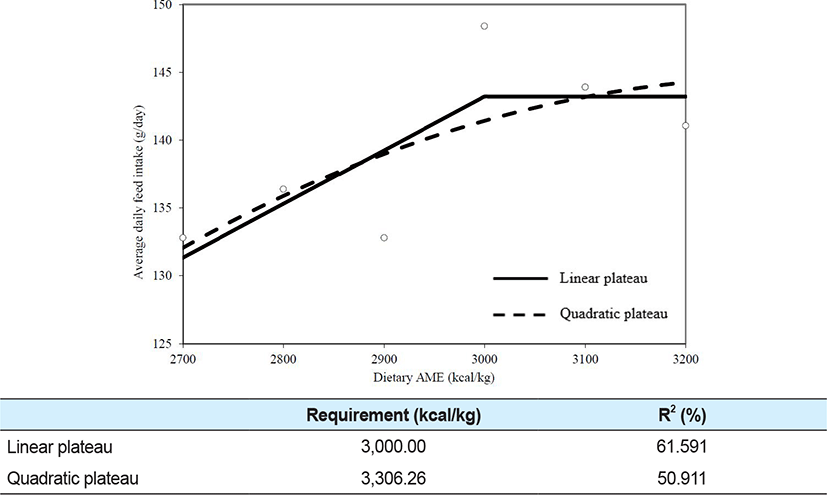
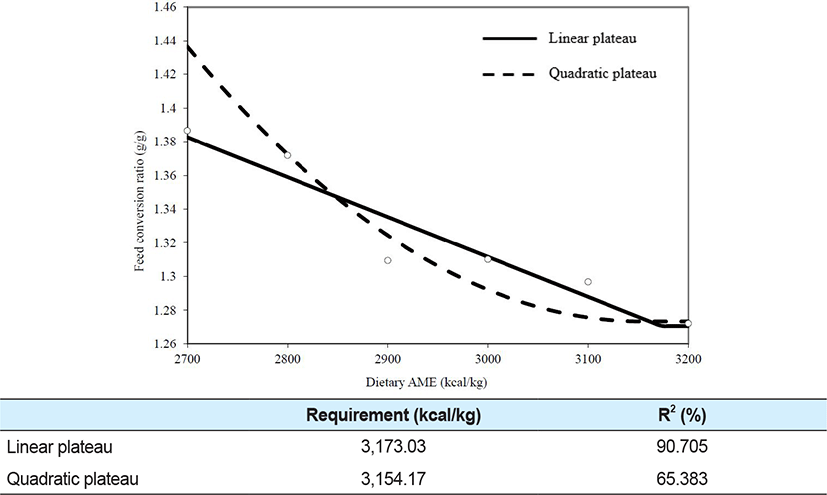
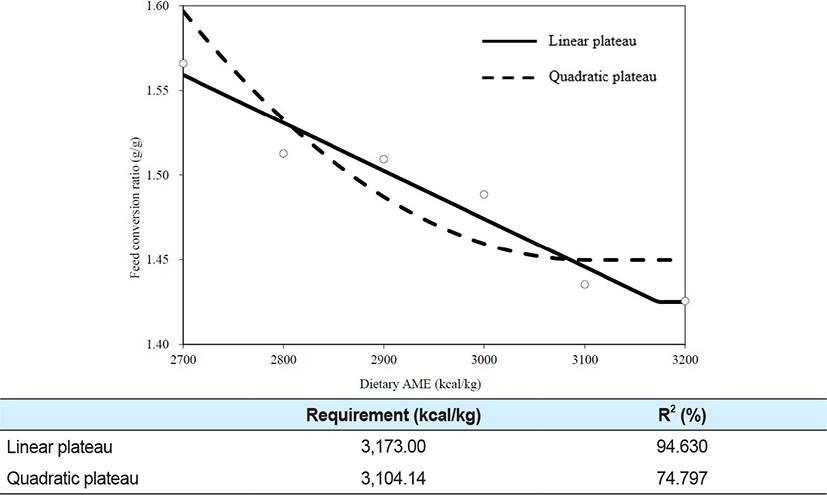
DISCUSSION
The dietary AME level is a critical issue in the animal production field. This is because the optimization of the nutrient requirement is a really important step to cut down on the production cost while maximizing productivity. Following previously published data, feeding a higher dietary AME level diet could improve growth performance parameters such as BW, ADG, ADFI, and FCR [1–5]. In this study, the growth performance and carcass traits data obtained agree with previous studies that showed that starter Pekin ducklings fed a lower energy diet recorded higher feed intake and thus increased feed conversion [11,12,17,18]. This could be because a lower dietary AME diet makes animals consume more to reach the required energy level. The current data also supports the theory that the effect of dietary energy level on the performance of growing birds is dependent on the birds’ capacity to alter feed intake to meet changing demands for calories [19,20]. As a result, birds fed a higher dietary AME diet showed improved feed efficiency [1–4].
Dietary AME levels could also influence the carcass traits. Previous research suggested that dietary energy causes the deposition of excess abdominal fat or carcass fat in broilers [1,4,8,21], and ducks fed a high dietary AME level diet can accumulate larger amounts of abdominal fat [11,18,22]. The high abdominal fat accumulation trait could negatively affect the consumers’ choices [23,24].
Increasing dietary AME shows no differences (p > 0.05) in breast meat yield while leg meat yield is increasing in broilers [3,8,17,21].
Looking at the concept of broken line analysis as suggested by Whittemore and Fawcett [25] states that when the dietary nutrient is over the threshold, then the performance nearly keeps staying on the most improved side. That overlapped point between the highest performance graph and regression graph is called the broken point and can be regarded as the maximum dietary requirement. Figs. 1 to 6 present the requirement of linear and quadratic plateau analysis results. The requirement of linear plateau shows from 3,000.00 kcal/kg to 3,173.03 kcal/kg whereas the requirement of quadratic plateau ranges from 3,100.00 kcal/kg to 3,306.26 kcal/kg. Those gaps between linear and quadratic plateau requirements came from the characteristic of the regression graph. Some research [26] suggests that estimation by quadratic regressions can be overestimated when the requirement was not centered in the experimental nutrient. Therefore, the linear plateau requirement could be a more accurate maximum dietary AME level. Previous study suggested that the dietary AME requirement level is nearly 2,755.75 kcal/kg [11], which is lower than the estimated maximum AME level. The currently estimated requirement based on growth performance is much higher than that of the previous experiment because of the improved genetic performance of the modern White Pekin duck. Maximum dietary AME level should be selected based on the purpose of the diet formulation and the balance of the growth performance and abdominal fat accumulation.
